|
The Ballyannan Wood Steering Committee was established
to prepare a management plan for Ballyannan Wood. The Steering Committee includes representatives from Coillte, Cork County
Council, the County Nature Trust, East Cork Area Development Ltd., Midleton Town Council, and the National Parks and Wildlife
Service. Sylvan Consulting Ecologists (www.sylvaneco.com) were commissioned to prepare the management plan under the direction of the
steering committee.
| Ballyannan bluebells |
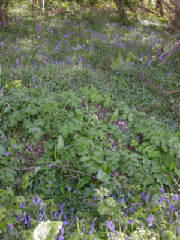
|
| Photo: Michael O'Keeffe |
Objectives
The objectives of the
management plan are to:
-
Maintain and enhance existing features of nature conservation importance.
-
Create and enhance features which are characteristic of woodland ecosystems
in Ireland, so that they can be used for educational/interpretative purposes.
-
Demonstrate typical methods of woodland nature conservation and monitor their
effects.
-
Provide facilities for walkers, especially local residents, particularly
as visitor numbers are expected to increase.
-
Develop interpretative facilities.
-
Honour the place of Ballyannan Wood in the heritage of the Midleton town,
from personal memories to archaeological features.
-
Retain economic options with regards to timber production.
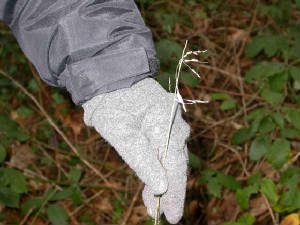
|
| Wood millet. Photo: Michael O'Keeffe |
Special features
The management plan
has identified the special features of Ballyannan Wood. Management will be focussed
on maintaining and enhancing these features.
Features
of nature conservation value:
-
Ancient woodland status.
-
Wood Millet (Milium effusum) population.
-
Ash woodland (sub-compartment 2) and associated rare snail (Perforatella subrufescens) population.
-
Veteran trees and saproxylic invertebrate populations.
-
Reedbed/willow woodland and associated invertebrate populations.
-
Speckled Bush-cricket (Leptophyes
punctatissima).
-
Breeding colony of Little Egret (Egretta
garzetta).
-
Red Squirrel (Sciurus vulgaris) population.
-
Whiskered Bat population (Myotis
mystacinus; status requires confirmation).
Heritage
and education features
-
Variety of tree species.
-
Vernal flora.
-
Diverse recreational experiences in different habitats.
-
Elements of serenity and quiet valued by walkers.
-
Potential for educational use both for the public, schools, and third-level
institutions.
-
Opportunities to demonstrate woodland habitat management techniques.
-
Opportunities for nestbox and batbox studies.
-
Old walls, ruins of cottages and boathouses, earthenbanks, and pillars.
-
Wishing Tree.
-
Gravel pits.
| Veteran tree |
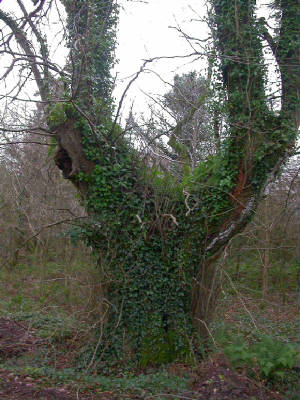
|
| Photo: Michael O'Keeffe |
SUMMARY
OF ACTION PLANS
Maintenance
of woodland / minimum intervention:
-
Continuation of woodland cover to maintain ancient woodland status. Management
operations to result in no more than 0.25 ha gap at any one time.
-
Identification of the factors contributing to the expansion of the wood millet
population between 2003 and 2006.
-
Maintenance of the existing ash stand into the future with minimal intervention.
-
Carry out risk assessment of veteran trees, especially those near walkways,
by trained Coillte personnel in cooperation with a saproxylic invertebrate expert.
-
Maintain all existing veteran trees where possible. Identify and map or tag
all potential future veterans.
-
Maintain shady deciduous broadleaf components at least in part of the stand.
-
Maintain tall trees in the woodland to continue to host the Little Egret
nests.
-
Maintain populations of small-seeded trees such as Scots pine.
-
All forest operations should be confined to existing rides to prevent further
disruption of the soil and ground flora.
Monitoring:
-
Assess condition of the Wishing Tree.
-
Monitor wood millet population size.
-
Monitor wetland habitats annually including proportion of tree cover.
-
Monitor presence/absence of red squirrel or records of grey squirrel invasion
annually.
-
Confirm status of Whiskered Bat population.
-
Monitor condition of old walls, ruins of cottages, earthenbanks, and pillars
and use appropriate methods to maintain or reconstruct walls as needed.
-
Analyse the feasibility and desirability of restoration of the Wood Rangers
cottage or a boathouse.
Habitat
creation or improvement:
-
Design and create a
small wetland.
-
Develop and implement dead wood and rot hole policy.
-
Plant blackthorn and hawthorn shrubs in open areas close to veteran trees.
-
Cut selected areas periodically to create small grassy open spaces.
-
Transform sycamore slowly by creating small openings in the canopy and allowing the development of a more diverse
structure (to oak).
-
Erect nest boxes and bat boxes.
| Bramble clearance |
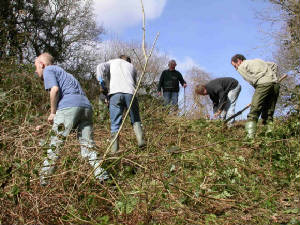
|
| Photo: Michael O'Keeffe |
| Scrub invading marsh in Ballyannan |
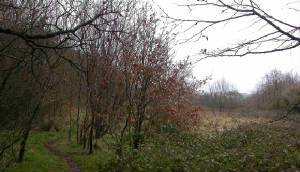
|
| Photo: Michael O'Keeffe |
Recreational
facilities
A zoning system has been developed according to expected use (1) and
a graded network of walking routes (2) has been designed to match the level of
use expected. The walking routes will include a nature trail with a series of interpretation boards providing information
about the history and ecology of the wood (3).
(1) Zoning map (click here for larger image)
(2) Walking routes map (click here for larger image)
(3) Interpretation signs map (click here for larger image)
-
Level and surface main path to glade.
-
Erect kissing gate or other access for wheelchairs that excludes quads, etc.
-
Erect welcome sign and interpretation signs.
-
Erect directional and reassurance markers on trails.
-
Develop litter bins in car park and add signage about litter in the woods.
-
Instigate tradition of litter removal with volunteers once or twice a year.
-
Maintain facilities.
Education
and interpretation:
-
Development of a brochure or background flyer in non-technical language to
help primary or secondary school teachers use Ballyannan Wood as a teaching tool.
-
Development of detailed information, such as a nature trail, on the Internet
for download by walkers and by teachers.
-
Provisions of guided walks for teachers or school groups.
-
Establishment of a license or permit system for schools.
-
Explore employment options for guided walks and safety.
-
Promote Ballyannan as an educational resource on the Internet, radio, and
through publications.
-
Include Ballyannan on Coillte’s list of old woodlands in the district
Strategic Plan.
|

